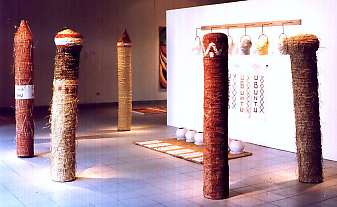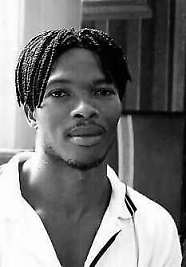Nkosinathi Khanyile

Artists
- Wim Botha
- Bob Cnoops
- Hugo Crosthwaite (Mexico)
- James de Villiers
- Sasha Fabris
- Gordon Froud
- Rookeya Gardee
- David Hlynsky (Canada)
- Ashley Johnson
- Nkosinathi Khanyile

DASART shows
Transmigrations - the show
Fokofo
Dasart Archives
Title: Isintu
Materials: Welded wire, grass (ilala), cow dung, clay (ibomvu & umcako) and beads.
Isintu - that which is done by human beings. Abantu - a message of good-will and hope. The roots of "isintu" are elements of African philosophy of life and cosmology. Isintu is part of "ubuntu", all that which is part of African beliefs, culture, customs, identity, norms and values.
This art work stands as a symbolic monument to celebrate African renaissance, through the realisation of the issues which address the notions of what is to be human, being African and being black. The concepts "umuntu, ubuntu and isintu" are the back-bone of African identity.
This installation arouses the sense of a specific ceremonial occasion within the network structure of African culture. I see this work as the deeper spiritual ceremony - my ancestors celebrate the talent and achievement of my fore-fathers. Where the artist is not the creator, but is the tool or a messenger sent to fulfil a specific task on earth. When the task is fulfilled there is celebration that the work reflects spiritual healing power to both the artist in the form of a dream, which could be about the visions on the past, present and yet to come.
The upright position and standing together of the pillars affirms the notion of "buntu", which denies individualism, but favours community and unity. The work also reflects the physical and spiritual power brought about by unity of things - things that become the symbol of human beings. I therefore see this installation as a true reflection of the "New South Africa", a key solution to the past history of apartheid and all the inhuman activities of the past regime. The standing together of these pillars directly reflect the coming and working together of the artist and several women artists to make this work a success.
On another level this installation is not only a praise for African women, but is also a calling for the emancipation and holistic empowerment of women, especially those in rural areas. Socio-political, economical and educational empowerment of the underprivileged rural community of women will mean not only their total recognition for existence, but moreover their right to fully participate in the Nation building. This installation re-affirms the above statement hence the pillars took the exaggerated form and shape of the traditional 'African Dolls' (especially those made by women in KwaZulu Natal). Some of the pillars re-affirm the female spirits and power through their enlarged cylindrical tops, shaped like Zulu women's head-dress (the isicholo). The surface structure comes from the basketry weaving pattern and the coiling nature of African ceramic vessels, thus achieving the roundness of the object.
At one level the pillar becomes a monumental figure and symbol for the tribute to all political prisoners who stood together against all sorts of inhumane social, political and economic injustices of the past regime. The togetherness becoming the power-house to cure the past traumas, furthermore the generator of reconciliation and peace in this country. On the religious perspective this work is a symbol of the sacred mountain theme where God, spirits and human beings reside. The tallness and sharpness of the top becomes the antennae that connect heavens and earth. The idea of marking a sacred space for meditation and prayers. The cultural identity is indicated by the manipulation of specific materials (grass, clay, beads etc.) as for the use of coloured clay which connects with African beadwork. Within such colours a symbolic meaning and vocabulary of African culture is embraced.
Nkosinathi Isaac Khanyile
Top